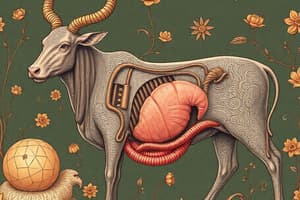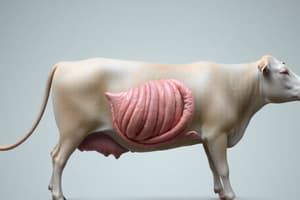Podcast
Questions and Answers
Unlike ruminants, horses are ______ fermenters, relying on a large cecum for microbial fermentation, which is a less efficient process compared to the rumen.
Unlike ruminants, horses are ______ fermenters, relying on a large cecum for microbial fermentation, which is a less efficient process compared to the rumen.
hindgut
The process of ______, common in rabbits, allows them to acquire nutrients produced by microbial fermentation in the cecum by consuming their own feces.
The process of ______, common in rabbits, allows them to acquire nutrients produced by microbial fermentation in the cecum by consuming their own feces.
coprophagy
Avian species depend on the ______ to grind their feed, as they lack teeth, making this organ crucial for mechanical digestion.
Avian species depend on the ______ to grind their feed, as they lack teeth, making this organ crucial for mechanical digestion.
gizzard
While ______ necessitate diets rich in highly digestible nutrients, ruminants are capable of flourishing on diets primarily composed of fibrous feeds.
While ______ necessitate diets rich in highly digestible nutrients, ruminants are capable of flourishing on diets primarily composed of fibrous feeds.
The effectiveness of nutrient use is subject to change among different types of livestock due to structural and functional variations in their ______ systems and metabolic activities.
The effectiveness of nutrient use is subject to change among different types of livestock due to structural and functional variations in their ______ systems and metabolic activities.
In monogastric animals, the ______ is the primary site for nutrient absorption, where enzymes from the pancreas and intestinal wall further digest carbohydrates, proteins, and fats.
In monogastric animals, the ______ is the primary site for nutrient absorption, where enzymes from the pancreas and intestinal wall further digest carbohydrates, proteins, and fats.
In poultry, the ______ is a storage organ where food is held before it is gradually released to the rest of the digestive system.
In poultry, the ______ is a storage organ where food is held before it is gradually released to the rest of the digestive system.
The rumen, reticulum, omasum, and ______ are the four compartments of the ruminant stomach.
The rumen, reticulum, omasum, and ______ are the four compartments of the ruminant stomach.
In ruminants, microbial fermentation in the rumen produces ______, which serve as a major energy source for the animal.
In ruminants, microbial fermentation in the rumen produces ______, which serve as a major energy source for the animal.
The ______ in poultry is a muscular organ that grinds feed, aiding in the mechanical breakdown of food particles.
The ______ in poultry is a muscular organ that grinds feed, aiding in the mechanical breakdown of food particles.
The ______ is known as the 'true' stomach in ruminants, secreting hydrochloric acid and enzymes like pepsin to digest proteins.
The ______ is known as the 'true' stomach in ruminants, secreting hydrochloric acid and enzymes like pepsin to digest proteins.
The process of ______, or chewing the cud, reduces particle size and increases surface area for microbial action in ruminants.
The process of ______, or chewing the cud, reduces particle size and increases surface area for microbial action in ruminants.
Gases produced during fermentation in the rumen, such as methane and carbon dioxide, are eliminated through ______ (belching).
Gases produced during fermentation in the rumen, such as methane and carbon dioxide, are eliminated through ______ (belching).
Flashcards
Hindgut Fermenter (Horse)
Hindgut Fermenter (Horse)
Horses digest fiber in their large cecum, like a less efficient rumen.
Coprophagy
Coprophagy
Rabbits eat their own feces to absorb nutrients from cecal fermentation.
Avian Gizzard Function
Avian Gizzard Function
Birds use a muscular gizzard to grind food due to the absence of teeth.
Monogastric Diet Needs
Monogastric Diet Needs
Signup and view all the flashcards
Ruminant Advantage
Ruminant Advantage
Signup and view all the flashcards
Digestive System
Digestive System
Signup and view all the flashcards
Monogastric
Monogastric
Signup and view all the flashcards
Digestion in the Mouth
Digestion in the Mouth
Signup and view all the flashcards
Crop (Poultry)
Crop (Poultry)
Signup and view all the flashcards
Gizzard (Poultry)
Gizzard (Poultry)
Signup and view all the flashcards
Ruminant
Ruminant
Signup and view all the flashcards
Rumen
Rumen
Signup and view all the flashcards
Abomasum
Abomasum
Signup and view all the flashcards
Study Notes
- The digestive system breaks down feed into components usable by the animal
- Digestive systems vary among livestock species, influencing feeding habits and nutrient use
- Livestock digestive systems are broadly grouped into monogastric and ruminant systems
Monogastric Digestive System
- Monogastric animals possess a simple, single-chambered stomach
- Digestion starts in the mouth via mechanical breakdown and enzyme activity
- Salivary amylase is present in some monogastric species
- The stomach stores food, mixes it with gastric secretions, and starts protein digestion
- Gastric secretions include hydrochloric acid and enzymes like pepsin
- The small intestine is the primary site of nutrient absorption
- The duodenum, jejunum, and ileum make up the small intestine
- Pancreatic and intestinal wall enzymes further break down carbohydrates, proteins, and fats in the small intestine
- Bile from the liver helps emulsify fats
- The large intestine absorbs water and electrolytes, forming feces
- The crop in poultry acts as a storage organ
- The gizzard in poultry is a muscular organ for grinding feed
- Poultry have a cloaca where digestive, urinary, and reproductive tracts meet
Ruminant Digestive System
- Ruminants have a four-compartment stomach
- The four compartments of the ruminant stomach are the rumen, reticulum, omasum, and abomasum
- The rumen is the largest compartment, acting as a fermentation vat
- Microorganisms in the rumen (bacteria, protozoa, fungi) break down cellulose and complex carbohydrates
- The reticulum aids in particle sorting and regurgitation for further chewing (rumination)
- The omasum absorbs water and some minerals from the digesta
- The abomasum is the "true" stomach, secreting hydrochloric acid and pepsin for protein digestion
- Ruminants can use fibrous feeds due to microbial fermentation in the rumen
- Microbial fermentation produces volatile fatty acids (VFAs), a major energy source
- Microbes synthesize B vitamins and essential amino acids
- Rumination reduces particle size and increases surface area for microbial action
- Gases from fermentation (methane, carbon dioxide) are eliminated through eructation
Comparative Aspects
- Horses are hindgut fermenters, using a large cecum for microbial fermentation
- Hindgut fermentation in horses is similar to the rumen but less efficient
- Rabbits practice coprophagy to obtain nutrients from cecal fermentation
- Avian species lack teeth, relying on the gizzard to grind feed
- Monogastrics need higher-quality, readily digestible diets
- Ruminants can thrive on fibrous feeds
- Ruminants convert low-quality feeds into valuable products like meat and milk
- The efficiency of nutrient use varies among livestock due to digestive and metabolic differences
- Environmental factors influence digestive function and animal performance
- Diet composition and feeding management are key environmental factors
- Understanding livestock digestive systems is vital for formulating diets and optimizing animal health and productivity
Studying That Suits You
Use AI to generate personalized quizzes and flashcards to suit your learning preferences.




